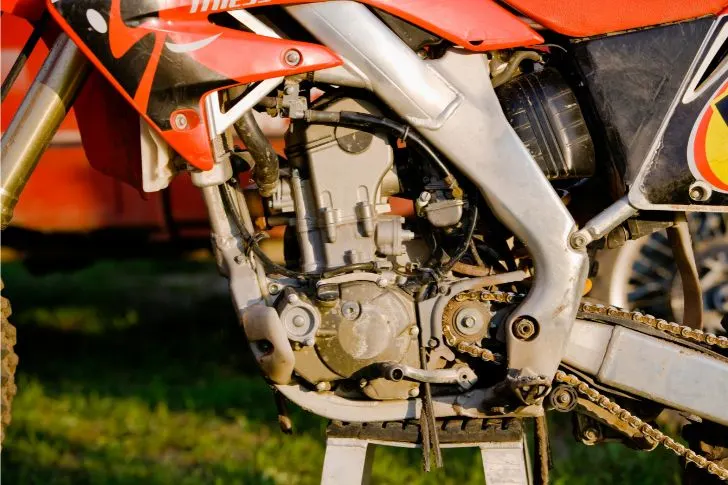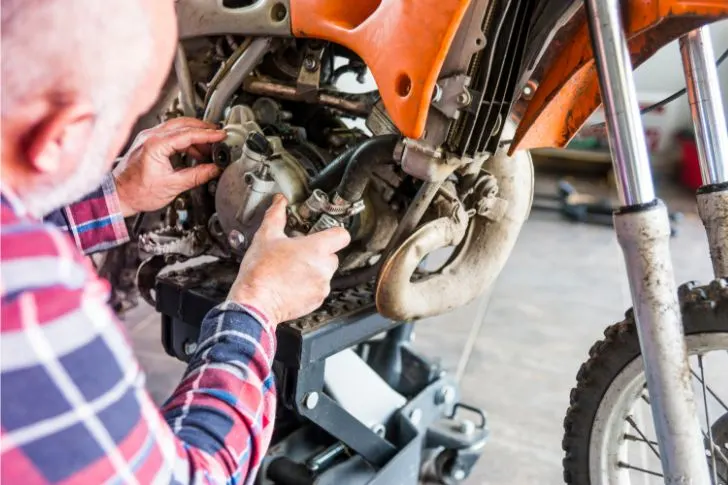Dirt bikes are the heartbeat of off-road adventures, unwaveringly humming with power and precision. But even these two-wheelers have a heart of their own — their engines! This article will explore these two kinds of dirt bike engines and how each defines the pulse of off-road adventures.
So, how do dirt bike engines work? As their names suggest, 2-stroke dirt bike engines complete a power cycle in two strokes — compression and power. 4-stroke engines do the same but with a longer cycle encompassing intake, compression, combustion, and exhaust. Both engine types have their own merits and cater to distinct preferences.
Dirt bikes and their popularity in off-roading may seem like the norm for the riding community nowadays. However, the journey of these rugged two-wheelers extends far beyond their origins.
To underscore how important dirt bikes play in everyone’s favorite sport and pastime, we’re not going to delve into their history. Instead, we’ll spotlight the heart of these mighty thumpers — their internal combustion engines.

The Core of 2-Strokes and 4-Strokes
The beginnings of internal combustion engines can be traced back to the 17th century before the 1st Industrial Revolution took flight. At the time, industrial builders were drawn to the concept of a self-contained power unit, recognizing its appeal and necessity. Initial prototypes of ICE developed during this period all aimed to address drawbacks in the steam engine’s heft and inconvenient operability.
Of course, earlier prototypes weren’t immediately successful and had to undergo multiple design revisions before becoming mainstream. But they held much promise — and we all know how that went.
Fast-forward to two and a half centuries later, revheads like you and I are reaping the benefits of straddling a two-wheeler with formidable 2-stroke and 4-stroke power mills.
Internal Combustion Mechanisms
Still on power mills, let’s define a modern internal combustion engine.
Internal Combustion Engines (ICE) generate power by burning fuel within the engine. They operate on the basic principle of converting chemical energy to mechanical energy to propel a vehicle forward. Both 2-stroke and 4-stroke dirt bike engines fall under this category — alongside the engines in most automobiles, aircraft, and power equipment (among other means of travel).
Role of Air, Fuel, and Ignition
In all ICE-equipped modes of transportation, the combustion process remains consistent. This core procedure demands three vital elements — fuel, air, and ignition — and begins with air-fuel mixture intake into the combustion chamber. The latter is then compressed and ignited by a spark plug. After which, the resulting explosion generates the force that drives other components to produce mechanical power.
The choice of gasoline, diesel, or alternative fuels in Internal Combustion Engines (ICE) varies depending on engine type. Subsequently, the chosen fuel mixes with air in specific ratios, creating a combustible mixture.
Irrespective of the situation, the type of fuel, the carefully calibrated mixture ratio, and the state of the air intake and ignition systems all significantly impact the engine’s performance and efficiency.
Converting Chemical Energy into Mechanical Energy
As earlier established, air, fuel, and ignition initiate and control combustion. However, converting chemical energy from this initial phase into mechanical energy involves several other components. These include the piston, cylinders, crankshaft, exhaust, and transmission.
Once stored chemical energy is liberated as heat, the piston descends within the cylinder, initiating linear motion. Simultaneously, high-pressure gases from combustion drive the crankshaft’s rotation.
As the mechanical output, the crankshaft channels this rotational energy to the transmission and wheels. The cycle concludes with the exhaust expelling residual gases and priming the engine for the next combustion cycle.
Anatomy of Dirt Bike Engines

While the rudiments of internal combustion engines in dirt bikes align with those explained in the preceding sections, their inner workings involve more than cylinders, crankshaft, exhaust, transmission, and pistons.
Specific components responsible for air-fuel mixture, tuning, and temperature regulation are also essential to the combustion process and a dirt bike’s off-road functionality.
Carburetor
In dirt bikes, a carburetor ensures the optimal air and fuel mixture before entering the combustion chamber. Achieved through precise carburetor tuning, this optimal mixture ensures efficient combustion, maximizing power output and overall performance.
Deviations in the mixture (quality or ratio) can lead to incomplete combustion or excessive richness, directly impacting engine efficiency, power delivery, and fuel economy — thus significantly influencing the combustion process.
Fuel Injectors
Like carburetors (view on Amazon), fuel injection systems guarantee the entry of optimal air-fuel mixture into the combustion chamber. They achieve this by electronically controlling fuel injection, resulting in precise amounts and timing.
This electronic precision, in turn, allows for accurate adjustments based on factors such as engine speed, load, and temperature, optimizing the air-fuel mixture for combustion efficiency.
Air Filter
A high-quality air filter ensures that only clean and debris-free air enters the combustion chamber. It also prevents particles like dust and dirt from reaching the engine, maintaining the integrity of the air-fuel mixture.
This, in turn, promotes efficient combustion, prolongs engine life, and optimizes overall performance by preventing potential damage and maintaining the required air-fuel ratio. That said, dirt bikes often have specialized air filters to serve this function during off-road rides.
Power Valve
The power valve plays a crucial role in optimizing the combustion process. Adjusting the exhaust port’s size influences power delivery and combustion efficiency across different RPM ranges.
This dynamic adjustment ensures optimal engine performance at various speeds, enhancing torque and power output. For this reason, some high-performance dirt bikes incorporate a power valve in the exhaust system (view on Amazon).
Expansion Chamber
Many dirt bikes feature an expansion chamber in the exhaust system, designed to improve engine performance. Specifically, the expansion chamber augments the velocity of exhaust gases as they exit the engine.
This high velocity is crucial for creating a scavenging effect, wherein the exiting exhaust gases help draw a fresh air-fuel mixture into the combustion chamber during the intake cycle.
This scavenging effect, enhanced torque and horsepower, powerband optimization, and backpressure reduction promote a more efficient combustion process.
Clutch
Temporary transmission disengagement is instrumental during gear changes. The clutch plays a vital role in making this happen.
As the clutch affords a rider smooth transitions between gears without necessitating a complete stop, it also enables the engine to remain operational — ensuring a continuous power supply to the combustion chamber.
This control over the transmission heightens combustion efficiency, leading to smoother power delivery and improved performance across diverse riding conditions.
Cooling System
While a dirt bike’s cooling system primarily regulates engine temperature to prevent overheating, its influence on combustion efficiency is indirect. Nonetheless, it ensures the engine operates within an optimal temperature range.
The cooling system contributes to consistent fuel vaporization, ignition, and combustion, promoting efficiency and preventing issues like pre-ignition or detonation.
Between liquid and air cooling systems, the former is more effective in maintaining a consistent temperature and ensuring optimal combustion efficiency.
Using coolant circulating through a radiator (view on Amazon), liquid-cooled engines prevent overheating. In contrast, air-cooled engines use airflow to dissipate heat, resulting in less precise temperature control.
How 2-Stroke Dirt Bike Engines Work
Since we’ve covered most of the components responsible for the power dynamics inside a dirt bike engine, it’s time to go into further detail with the two engine types — starting with 2-stroke engines.
A 2-stroke dirt bike engine operates through two distinct strokes in a single cycle (hence the name), showcasing a streamlined combustion process. In the first stroke (suction and compression), the piston rises, creating a vacuum in the crankcase and drawing in an air-fuel mixture.
The ignition of this mixture initiates the second stroke (power and exhaust), transferring power to the crankshaft. Simultaneously, the exhaust port opens, facilitating the expulsion of exhaust gases.
There are usually three ports on a 2-stroke engine — the inlet, transfer, and exhaust. During the first stroke, all these ports are closed. Their orientation reverses when the spark plug ignites the compressed air-fuel mixture above the piston and transfers the resulting power via the connecting rod to the crankshaft.
2-stroke engines offer several advantages. They’re notably lightweight, often weighing up to 50% less than their 4-stroke counterparts. Historically, these power mills exhibit superior acceleration and deliver enhanced torque at higher RPMs.
This, combined with firing once every revolution, allows for up to twice the power output of a 4-stroke engine with a similar cylinder capacity.
How 4-Stroke Dirt Bike Engines Work
In a 4-stroke engine, the number of strokes in a single cycle doubles compared to its 2-stroke counterpart. The first stroke is intake, the second compression, the third combustion, and the fourth exhaust.
- The piston descends in the initial stroke (intake), opening the intake valve to draw in a charge.
- Compression (second stroke) follows, both valves closed, compressing the fuel-air mixture as the piston ascends.
- The third stroke (combustion) occurs when the spark plug ignites the mixture, forcing the piston down to deliver power.
- Finally, the fourth stroke (exhaust) sees the exhaust valve opening, expelling the burnt air-fuel mixture.
This entire process occurs above the piston, which is why 4-strokes have larger cylinder heads — to accommodate camshafts, valves, and the spark plug (among others). Meanwhile, the housed crankshaft utilizes oil for lubrication and cooling, often aided by pressurized oil systems.
This configuration is specific to 4-stroke engines since the crankshaft isn’t utilized in the intake tract. However, whether or not this is a small price to pay in exchange for firing once every other revolution is left to personal discretion.
Is a 2-Stroke Faster than a 4-Stroke?

Although slightly off-topic, this question is almost always asked following discussions about how 2-stroke and 4-stroke engines work. It’s understandable. Without a doubt, torque and power output influence the speed rating of dirt bikes. And these two elements — plus several other factors — differ significantly between 2-strokes and 4-strokes:
2-Stroke Engines
- Typically, they have higher power-to-weight ratios, offering strong acceleration and power delivery.
- Generate power with every revolution, leading to quicker throttle response.
- Well-suited for situations where rapid acceleration and high RPM performance are crucial
4-Stroke Engines
- Generally provide more torque at lower RPMs, contributing to smoother and more consistent power delivery.
- Longer power stroke provides linear and predictable thrust, enhancing the bike’s ability to accelerate and maintain speed.
- Well-suited for maintaining higher speeds on straightaways and ensuring stable performance in various riding conditions
Determining the faster engine depends on a rider’s preferences, specific riding conditions, and terrain type. It also depends on the extent to which speed-enhancing mods are pursued. In some scenarios, the explosive power of 2-strokes may offer a speed advantage, while the consistent torque of 4-strokes can excel in maintaining higher speeds.
Speed rating shouldn’t be your top reason for a specific dirt bike. Instead, choose based on your riding style, priorities, mechanical inclination, and the demands of the race or terrain where you intend to ride.
Conclusion — How Do Dirt Bike Engines Work? (2 & 4 Stroke)
Although there are nuances in the configuration of these dirt bikes, their engines share a common goal — breathing life into the two-wheeler you love to take on outdoor adventures! Were it not for emissions considerations and availability, the precedence of one over the other would have been inconsequential.
Nonetheless, these setbacks make understanding the inner workings of each engine crucial. Knowledge of their mechanisms will help you reassess your priorities and preferences. Once that’s sorted out, you should be able to use the same insights to guide your decision-making process.
Kris is an avid off-roader and outdoor enthusiast who loves to brave the elements and take on challenging terrain. He also enjoys sharing his passion and knowledge with others so that they, too, can appreciate the ride.
About Kris
